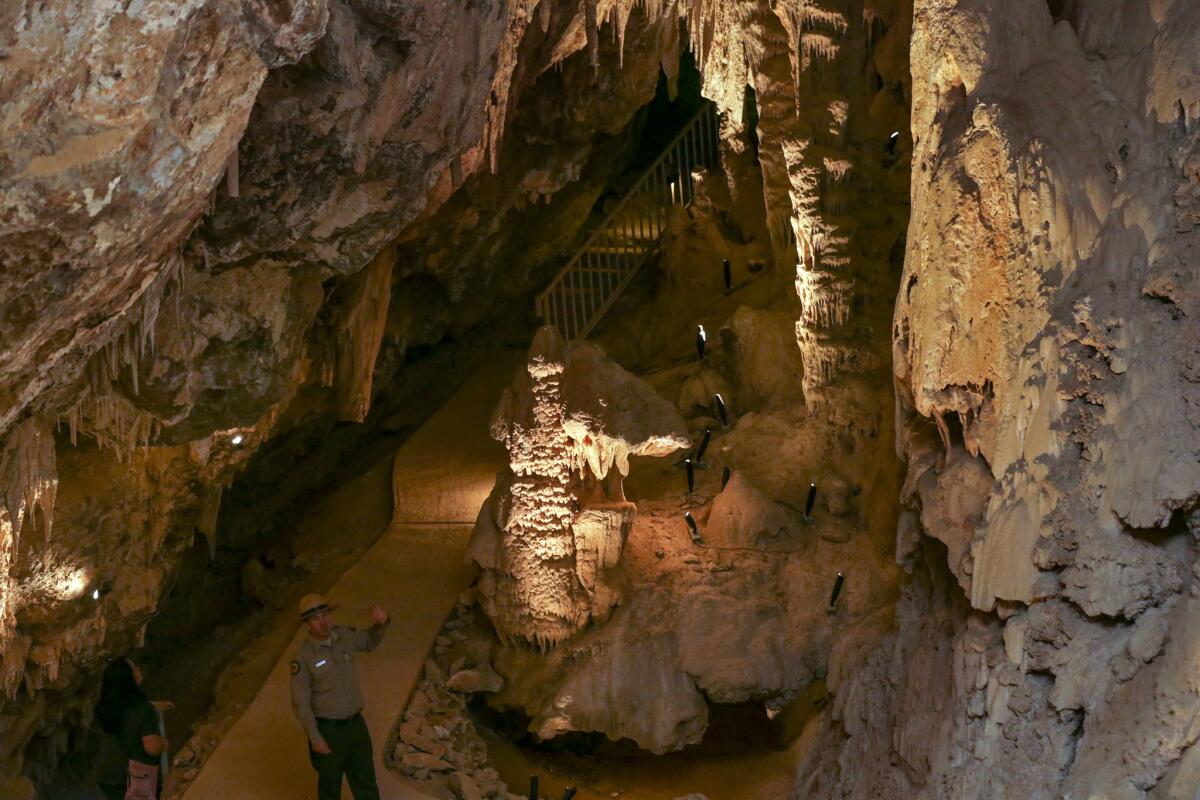After years of closure, attacks by vandals and extensive repairs, the Mojave Desert’s caverns are set to reopen

Mitchell Caverns will reopen in November, seven years after vandals plundered and damaged the Mojave Desert tourist attraction. (Irfan Khan / Los Angeles Times)
- Share via
The isolation of Mitchell Caverns, the only limestone caves in California’s state park system, has proved both a blessing and a curse.
Hidden in a narrow canyon in the eastern Mojave Desert, the caverns that opened to the public more than 80 years ago are a lure for geology fans and outdoor adventurers. Their glittering passages and chambers are the main attraction of the 5,900 acre Providence Mountains State Recreation Area, home to ringtail cats, desert bighorn sheep and one of the only known colonies of Gila monsters west of the Colorado River.
But officials closed the caverns in 2010 after the two rangers who patrolled the area retired and were not replaced amid budget cuts.
That’s when the vandals moved in.
They ripped out thousands of feet of electrical copper wire; stole diesel-powered generators, metal signs and flashlights; and ransacked a rock-and-mortar visitor center located about 16 desolate miles north of Interstate 40.
Now, after extensive renovations and repairs, the caverns and visitor center are scheduled to reopen to the public Nov. 3.
“It’s great to be back in the caves,” ranger Andrew Fitzpatrick said one recent day while standing in a pitch-dark chamber just beyond the entrance, his flashlight illuminating gnarled tendrils of flowstone that sparkled in its beam.
“It was a long process fraught with challenges — including funding issues, delays and environmental requirements,” he said. “But I think people are going to like what we’ve accomplished here.”
It could not happen soon enough for John Marnell, 72, a spokesman for the Committee to Reopen Mitchell Caverns, a nonprofit formed in 2013 to muster donations to help expedite repairs.
“The delays in reopening have been excruciating, the excuses plentiful,” he said. “But it does no good to stay angry. I can’t wait to get back into the caves and let the improvements speak for themselves.”
Along with upgrading the recreation area’s water system and refurbishing the visitor center, contract workers and members of the California Conservation Corps crews have installed a pedestrian bridge along a trail leading to the caverns. They’ve replaced the old incandescent bulbs in the caves with LED lights that sharply define the contours and shadows of thousands of formations deposited over eons by water seeping through soluble fissures of limestone.
From a distance, the two entrances to the caverns resemble menacing eyes on a fractured cliff face — blackened by smoke from the fires of Chemehuevi Indians, who used them for shelter, storage and ceremonial purposes.
“Let’s take a look,” Fitzpatrick said as he led a group of visitors down a flight of stairs and along a paved trail descending into the dark interior. The ranger flipped a switch on an electrical box, illuminating a vaulted gallery where water dripped from still-growing rock formations. The airflow in the chambers is warm and damp, the humidity and temperature are constant.
“Wow,” said Russ Dingman, acting superintendent of the state parks’ Tehachapi District. “The more you look, the more you see — and there’s a lot going on here.”
Every few yards, Fitzpatrick pointed out buried treasures: two-story-tall stalagmites seemingly standing guard just beyond the entrance, limestone walls indented with cavities glittering with crystals, bizarre bulbous formations reminiscent of toadstools.
Lurking in dark passageways and crevices were creatures that do not rely on the sun: pseudoscorpions smaller than the head of a match, Townsend’s big-eared bats navigating through the air via ultrasonic beeps, wood rats and Niptus beetles only found in the caverns.
Fossils of the earliest inhabitants — including prehistoric ground sloths — are buried beneath the caverns’ floors.
The Mitchell Caverns visitor center had been the home of the area’s original owners, Los Angeles businessman Jack Mitchell and his wife, Ida. The couple moved to the desert to open the caverns as a tourist attraction in the 1930s and sold them to the state in 1954.
A memorial plaque says the Mitchells wanted the state to preserve the area and the caverns “for future generations to appreciate.”

ALSO
California gets its own official state dinosaur
Trump may strip protections from 10 national monuments
These are the 10 ecologically sensitive landscapes and marine preserves Trump may be targeting
Sign up for Essential California
The most important California stories and recommendations in your inbox every morning.
You may occasionally receive promotional content from the Los Angeles Times.








